Cincinnati Reds: Top five home runs in team history


Over the course of 150 years of professional baseball, the Cincinnati Reds have had their share of memorable home runs. Let’s recap the five most noteworthy blasts in franchise history.
The Cincinnati Reds record books are littered with prodigious power hitters. Frank Robinson, Ted Kluszewski and George Foster are just a few of the names that rank high on the club’s all-time long ball list. However, did any of those names produce one of the Top Five home runs in franchise history?
Launch angle, exit velocity and bat speed have become synonymous with the round-tripper and scouts have searched for power hitters like never before. The display we saw last August from Aristides Aquino and the record-breaking season 2019 season from Eugenio Suárez are illustrations of the fan’s obsession with the home run.
When you have a history as deep and rich as the Reds, it’s going to be difficult to crack the Top Five. After all, the franchise has been in existence for 150 years, won five World Series titles and made 15 playoff appearances, so there are countless important blasts to choose from.
How difficult was this task? Nearly impossible. Just in the relatively short history of Great American Ball Park, Reds Country has witnessed memorable round trippers from the likes of Adam Dunn, Michael Lorenzen and Scooter Gennett. Enough with all the suspense. Here are the Top Five home runs in Cincinnati Reds franchise history.
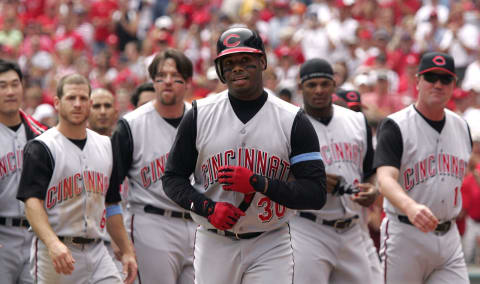
5. Ken Griffey Jr. joins the 500 club
By the time Ken Griffey Jr. joined the Cincinnati Reds prior to the 2000 season, his legend had already been well established. At the time, he was arguably the best player in the game and blasted 398 homers as a member of the Seattle Mariners. Needless to say, after inking a nine-year extension to play for his hometown Reds, the Queen City was destined to see it’s share of history-making moments.
During his tenure with the Reds, Griffey Jr. would reach the 400 and 600 home run milestones, but it was number 500 that proved to be the most memorable. Even though the road to No. 500 had its stressful moments, it could not have ended any more perfectly.
On Sunday, June 13, 2004, against the Indians at Jacobs Field, Ken Griffey Jr. blasted homer No. 499 to place himself on the doorstep of baseball history. Following a single makeup date in Philadelphia against the Phillies, the Reds returned home for a brief three-game homestand against the Texas Rangers. There’s little doubt Junior felt pressure to reach the 500 homer plateau in front of the home fans.
However, fate had other ideas for Junior. Griffey Jr. would sit out the game in Philadelphia and had a decent series against the Rangers, going 3-for-11 at the plate, however, he failed to connect for a home run. Next, the Reds were on the road for a Father’s Day weekend series in St. Louis against the Cardinals.
Through the first two games of the series, Junior collected two hits in seven at-bats, but No. 500 had still eluded him as the final game of the set approached on Father’s Day, June 20, 2004. With his dad, and former Reds great, Ken Griffey Sr. in attendance, Junior connected in the sixth inning off the Cardinals’ Matt Morris to become just the 20th member of the 500 home run club.
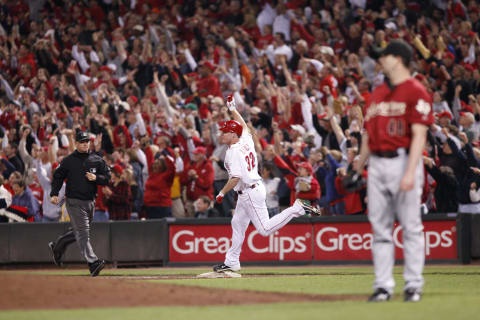
4. Jay Bruce sends the Reds to the playoffs
Fifteen long years of frustration were vanquished with one swing of the bat. After capturing the National League Central in 1995, the Cincinnati Reds went through one of their most futile stretches in franchise history.
Producing just two winning seasons in 15 years, the 2010 Reds entered the season with nine consecutive losing campaigns staring them in the face. Blessed with a young exciting core of players like Joey Votto and Brandon Phillips, the club also featured veterans such as Scott Rolen and Bronson Arroyo who knew what winning teams looked like.
However, it would be the player that many in the Cincinnati Reds organization had pinned their hopes on since being drafted in the first round of the 2005 MLB Draft that would provide the decisive blow.
Since his highly anticipated debut in 2008, many in Reds Country were prepared to anoint Jay Bruce as the next Reds superstar. While Bruce had an outstanding 2010 season and career as a member of the Reds, it was Joey Votto who would the earn accolades many thought would be Bruce’s birthright.
Nonetheless, to this point in his career, Joey Votto has never had an at-bat more memorable than Jay Bruce’s trip to the plate in the ninth inning of a tie game against the Houston Astros on September 28, 2010.
With the Reds needing one victory to secure their first division title and playoff appearance in 15 years, Jay Bruce sent the first pitch of the bottom of the ninth inning from Astros left-hander Tim Brydek over the center field wall in front of a raucous crowd to send the Reds to the postseason. And with one swing of the bat, Jay Bruce exorcised a decade worth of demons among the Reds faithful.
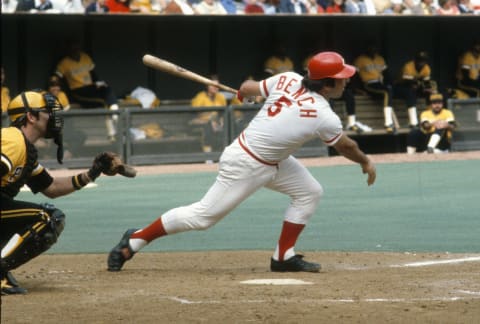
3. Johnny Bench saves the season
Even though Reds Country likes to think of the Big Red Machine era as a time when their beloved Reds simply steamrolled everyone in their way, history tells us that’s far from the truth. As a matter of fact, a strong argument could be made the Reds were prohibitive underdogs to the Pittsburgh Pirates entering the1972 NLCS.
The Pirates entered the 1972 season as the defending World Series champions and posted an identical 95-59 record as the Reds to capture the National League East title. Featuring a lineup that included future Hall of Famers Roberto Clemente and Wille Stargell, the Cincinnati Reds faced a daunting task.
Related Story. Reds Top 10 all-time leaders in HRs
After splitting the first four games of the best of five series, a trip to the World Series hinged on a fifth and deciding game. Veteran and 19 game-winner Steve Blass got the call for the Pirates against the Reds 21-year-old southpaw Don Gullett.
Pittsburgh jumped out to a quick 2-0 lead in the second inning and never trailed as they entered the ninth inning with a 3-2 lead. As Pirate closer Dave Giusti took the mound, all signs pointed to a second consecutive NL Pennant for Pittsburgh. However, NL MVP Johnny Bench had a differing opinion.
Falling behind in the count, Bench lined a 1-2 pitch just over the right field wall to tie the contest and send Riverfront Stadium into a state of pandemonium. After consecutive singles from Tony Perez and Denis Menke, the Reds had the winning run in scoring position.
Right-hander Bob Moose replaced Giusti on the mound and immediately retired Cesar Geronimo on a fly ball, but pinch-runner George Foster advanced to third with only one out. After Darrell Chaney weakly popped out in the infield, Foster scampered home following a wild pitch to send Cincinnati to the Fall Classic.
Although the Reds would eventually succumb to the A’s in seven games, without Johnny Bench’s heroics setting in motion a comeback for the ages, the 1972 Cincinnati Reds would have never reached the World Series.
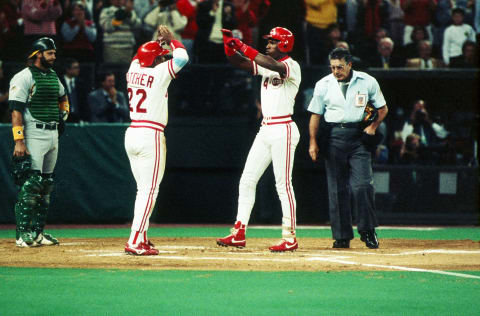
2. Eric the Red sends a message
In the late 1980s and early 1990s, the Oakland Athletics were the most dominant team in baseball. As the 1990 World Series got underway, the A’s were making their third consecutive trip to the Fall Classic and looking for back-to-back titles. Despite leading the NL West from wire-to-wire and dispatching the favored Pirates in the NLCS, the Reds were heavy underdogs against their AL counterparts.
However, someone forgot to share this information with the Reds and, specifically, Eric Davis. After Reds ace Jose Rijo set the A’s down in order in the top of the first inning of Game One, the Reds bats started what would soon become an avalanche that would engulf the A’s.
With two down and Billy Hatcher on first base following a one-out single, Cincinnati left fielder and clean-up hitter, Eric Davis, sent the first offering he saw from Oakland ace Dave Stewart over the center field fence with plenty of distance to spare, giving the Reds an early advantage that they would refuse to surrender.
Keep in mind, Dave Stewart was one of the best and most intimidating pitchers in the game, but as he glared at Davis as he gave his signature hop out of the batter’s box, everyone knew with one swing of the bat this series was over. Davis provided the Reds a confidence and swagger that would propel them to their first championship in 14 years.
That’s not to say the A’s wouldn’t fight back. You don’t win 103 games in the regular season without bowing down easily. But even the close games went in the Reds favor and Cincinnati closed out the series with a four-game sweep, recording the final out before a stunned Oakland A’s team and crowd.
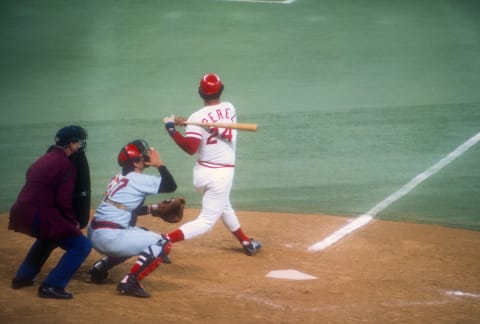
1. Tony Perez starts the comeback
Everyone remembers Game 6 of the 1975 World Series. Whenever someone is discussing the most memorable moments in MLB history, inevitably the conversation works its way to Boston’s Carlton Fisk pleading for his shot down the left field line to stay fair. Of course, we all know what happened regarding Fisk’s antics, but little mention is made of the pivotal home run hit during Game 7. Let’s change that.
Entering the 1975 Fall Classic, the Big Red Machine were heavy favorites. Winners of a remarkable 108 games during the regular season, the Cincinnati Reds were making their third trip to the World Series in six years. However, they had yet to hoist the World Series trophy.
The Reds were on the brink of being remembered as akin to the 1970s Minnesota Vikings or 1990s Buffalo Bills as teams good enough to reach the championship, yet always falter at the finish line.
If the Reds were ever going to stake their claim to a dynasty, they had to win a championship and losing to an underdog as great as the Red Sox would have forever sullied the reputation of the Big Red Machine.
Unfortunately, all signs pointed to another Reds meltdown in Game 7. Entering the top of the sixth inning, the Reds found themselves down 3-0 with defeat staring them straight in the face. With two out and Johnny Bench on second base, Tony Perez ahead in the count 1-0 got Boston’s Bill “Spaceman” Lee’s infamous slow curve that had fooled Perez twice already in the series. It didn’t fool him a third time.
The Big Doggie sent the Spaceman’s offering over the Green Monster and the comeback was on. An inning later, Pete Rose tied the game with an RBI single and in the top of the ninth inning, MVP Joe Morgan blooped a single with two outs into shallow center field in front of a charging Fred Lynn to give Cincinnati a 4-3 lead they would not relinquish.
Next. Reds Top 5 all-time MVP winning seasons
To a man, everyone on the Big Red Machine would claim Tony Perez was the player they would most like to see at the plate in a pressure situation. In the biggest at-bat of his career, The Big Doggie rewarded their trust and forever altered the course of the franchise.